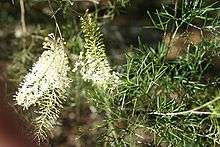Grevillea leptopoda
| Grevillea leptopoda | |
|---|---|
 | |
| Scientific classification | |
| Kingdom: | Plantae |
| (unranked): | Angiosperms |
| (unranked): | Eudicots |
| Order: | Proteales |
| Family: | Proteaceae |
| Genus: | Grevillea |
| Species: | G. leptopoda McGill. |
| Binomial name | |
| Grevillea leptopoda | |
The Grevillea leptopoda is a flowering plant originally found in Western Australia, mostly near Geraldton.
The spreading to erect shrub typically grows to a height of 1 to 1.5 metres (3.3 to 4.9 ft) and has non-glaucous branchlets. It has dissected leaves with a blade that is 30 to 80 millimetres (1.2 to 3.1 in). It blooms between August and November and produces a terminal raceme irregular inflorescence with white, pink or cream flowers with white styles. Later it forms rugose ellipsoidal fruit that are 9 to 11 mm (0.4 to 0.4 in) long.[1] It regenerates from seed only.[2]
It can be confused with Grevillea teretifolia which has a shorter floral rachis and longer pistils.
G. leptopoda is found in the Mid West and the Wheatbelt regions from Kalbarri south to Moora[2] growing among medium to low trees in tall shrubland, mallee or heathland It will grow in rocky, stony or sandy lateritic soils.[1]
The plant was first described by the botanist Donald McGillivray in 1986 in New Names Grevillea journal. It has a West Australian Flora Conservation Code of P3, which means it is poorly known.
G. leptopoda has heavily scented flowers and is used in domestic gardens in warmer areas.[3]
See also
References
- 1 2 "Grevillea leptopoda". FloraBase. Western Australian Government Department of Parks and Wildlife.
- 1 2 "Grevillea leptopoda ". Flora of Australia Online. Department of the Environment and Heritage, Australian Government.
- ↑ "Fact Sheet: A Native Cottage Garden". Australian Broadcasting Corporation. 1 October 2011. Retrieved 5 September 2016.

| Wikimedia Commons has media related to Grevillea leptopoda. |
